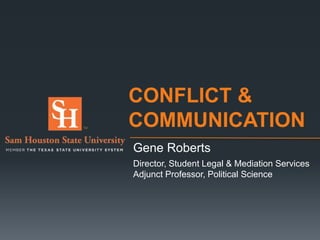Conflict & Communication
- 1. CONFLICT & COMMUNICATION Gene Roberts Director, Student Legal & Mediation Services Adjunct Professor, Political Science
- 2. Learn to think strategically about workplace conflict. Discover some tools to help manage conflict.
- 4. ď‚ž 47% of employees decreased their time at work ď‚ž 38% of employees decreased their work quality ď‚ž 78% said commitment to organization declined Harvard Business Review
- 11. When you are in conflict Your brain views it as a threat. Anxiety & Defensiveness Difficult to improve
- 12. ď‚ž Generational ď‚ž Divisional ď‚ž Financial ď‚ž Market ď‚ž Personality ď‚ž Goals
- 13. ď‚ž Face to face talking ď‚ž About the problem ď‚ž Without interruption ď‚ž Long enough ď‚ž To find a solution Dana Mediation Institute. Managing Workplace Conflict
- 14. ď‚ž Commit: We will stay with the process. ď‚ž Commit: We will not impose one-sided solutions Dana Mediation Institute. Managing Workplace Conflict
- 15. ď‚ž USPS: 90% satisfaction ď‚ž Toro: Costs decreased from $47,200 to $20,250 ď‚ž Georgia-Pacific: saved $42,000,000 in 10 years
- 16. ď‚ž Positions vs. Interests ď‚— Position: What do you want? ď‚— Interest: Why do you want it?
- 17.  Use Active Listening  No interruptions  Demonstrate listening  Give feedback—ask questions until you understand  Defer judgment
- 18. ď‚ž What is your procedure? ď‚— Mediation? Other internal procedure?
- 19. Gene Roberts, Esq. Sam Houston State University Student Legal & Mediation Services Box 2191 Huntsville, Texas 77340 936. 294.1717 gene.roberts@shsu.edu bearkatlaw.com linkedin.com/in/robertsgene @GeneRoberts
Editor's Notes
- #11: Protect mode to connect mode Adrenaline to oxytocin
- #12: Mediation provides and atmosphere of safety, time to process, removes “fight or flight” automatic responses, moves towards thinking processes. Fight or flight aren’t appropriate in a work session.
- #15: Requires us to choose to work toward a solution—a behavioral choice. Allows us to try to break fight/flight/freeze emotions.
- #17: Try to separate the person from the problem.
- #18: Improves communication; reflect back what was said to you. Makes up for differences in perceptions, biases, definitions, factual lapses. Restate what the speaker said to you.
- #19: Allows movement to rational part of brain; move from conflict to cooperation. Not me against you, but us against the problem.



















